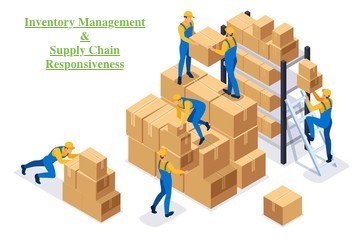
nventory management has always played a key part in any successful supply chain process. Managing inventory levels helps companies to swiftly adapt to unpredictable changes within the marketplace. Volatile demand can cause troubling issues when not handled correctly. That undermines supply chain performance and customer relationship management. When there are weaknesses in how managers link warehouse operations and manage supply chain innovation, the risk increases. In fact, 56% of business leaders still report inefficient inventory management capabilities, asserts Forbes. Let’s take a closer look at how your company can improve inventory management to boost customer experiences, purchase orders, and small business efficiencies.
The Importance of Inventory Management in Public Warehouse Operations
Digitization and automation are at the heart of ongoing growth and recovery and can help businesses overcome common warehousing and inventory issues. For instance, let’s say you are a company that sells seasonal jackets. Due to an unusually warm winter, your winter jackets no longer sell as expected.
Without adapting to the current demand, your winter jackets will become excess inventory over time. Using up public warehouse space to sort, organize, and store excess inventory can get costly.
These negative effects could have been prevented with an adaptive and responsive supply chain across all industries. Knowing how to link warehouse centers, supply lines, and shipping lanes efficiently can improve management and logistics for supply chains.
For example, retail and spa warehouse needs may vary greatly, but they all must still rely on data to track operational efficiency. It is crucial for all businesses looking to scale, to understand the importance of having the ability to shift production toward demand.
Steps to Take for Better Supply Chain Responsiveness And to Link Warehouse Operations
Correctly managing inventory levels and knowing how to effectively link warehouses requires a responsive supply chain, but what exactly does that mean?
According to IGI Global(n.d.), a strong supply network can be defined as a supply chain that is able to shift its production to unpredictable customer demand. How do supply chains do this?
One way to realize a responsive network is to correctly manage logistics warehouse and inventory levels..

Boost Inventory Management
Correctly managing Inventory levels can be a struggle, depending on the marketplace and products in question. See below the best ways you can effectively improve your inventory management by making your logistics warehouse processes more responsive.
Working with the best fulfillment partner can ensure inventory management remains front and center at all times. It allows companies to better regulate inventory and keep up with critical supply chain processes. This focus makes optimization and responsiveness much easier.

Improve Supplier relationships
Products that require multiple raw materials or parts from different suppliers are heavily reliant on active supplier relationships. Companies that trade in those products ought to continuously look for ways to improve their supplier relationships, including public warehouse access and utilization.
Having a better understanding of your supplier’s business position (and vice versa) allows a company to better anticipate and forecast possible disruptions and improve the way they coordinate and link warehouses and other applicable chain parties. This maximizes the throughput speed at which new materials can be ordered and received, in turn increasing your adaptability to the marketplace. Having access to the best supply chain tools can also help significantly. .
Figure 1(Supplier Relationship Management) Significance of Healthy Supplier Relationship. (n.d.). from https://www.strategicsourcing.pk/2015/12/significance-of-healthy-supplier.html
Enhance Risk Management
Another way to improve inventory control and build supply chain responsiveness is through effective risk management. Especially in turbulent times and strong unforeseen events such as COVID-19, the element of risk management is crucial for any business looking for ways to boost logistics warehouse operations and streamline operations.
Especially for SMEs (Small-Medium-Enterprises) looking to invest in new technology, a detailed risk analogy of the sought-after investment must always be made prior to continuing business. Automation and digitalization are important elements in linked warehouses nowadays. Despite the importance of these elements, never invest without proper risk-return analysis.

Consider Outsourcing Options
A method to the improvement of performance and inventory management that has become increasingly popular over the years is the concept of outsourcing. Companies such as ModusLink are industry experts with years of industry experience and knowledge regarding public warehouse and inventory management processes.
Companies that rely on warehouse and distribution services need sound logistics warehouse management processes. Without a solid foundation, the entire network will struggle from the start. For many companies, the easiest solution to this shortcoming is to outsource services.
Looking Forward to Future Growth and Success
Some companies today can also be price-competitive, increasing the attractiveness of outsourcing your supply chain. These companies use their extensive network, supplier relationships, and vast IT infrastructure to massively increase supply chain responsiveness and inventory management processes. They understand the importance of linked warehouse operations.
Companies that outsource effectively gain the ability to spend resources elsewhere. This allows their business to flourish in a short-time period and more importantly, increases their ability to scale effectively. The effects of COVID-19 have forever changed the market and how consumers shop, which has forever altered how inventory management and supply chain responsiveness is measured.
Improve Logistics Warehouse Operations With ModusLink
These three elements are important ways to Increase a supply chain’s responsiveness and in turn, increase inventory management. There are plenty of other ways a business can improve its supply chain strategy and boost the ability to link warehouses effectively.
Would you like to know more about these innovative strategies and how to improve supply chain operations with enhanced inventory management? Contact ModusLink today to learn more and to see how easy inventory management can be when you have the right tools and guidance!
Bibliography:
Amsler, S., O’Donnell, J., & Cole, B. (2021, February 11). inventory management. SearchERP. Retrieved November 24, 2021, from https://searcherp.techtarget.com/definition/inventory-management
Significance of Healthy Supplier Relationship. (n.d.). Strategic Sourcing. Retrieved December 3, 2021, from https://www.strategicsourcing.pk/2015/12/significance-of-healthy-supplier.html
Walts, A. (2021, October 29). Your Essential Guide to Effective Inventory Management + 18 Techniques You Need to Know. The BigCommerce Blog. Retrieved November 21, 2021, from https://www.bigcommerce.com/blog/inventory-management/
What is Responsive Supply Chain | IGI Global. (n.d.). IGI. Retrieved December 3, 2021, from https://www.igi-global.com/dictionary/building-a-strategic-framework-for-retail-supply-chain-analytics/52748